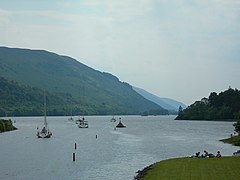Aberchalder
Aberchalder
| |
|---|---|
 | |
Location within the Lochaber area | |
| OS grid reference | NH340032 |
| Council area | |
| Country | Scotland |
| Sovereign state | United Kingdom |
| Postcode district | PH35 |
| Police | Scotland |
| Fire | Scottish |
| Ambulance | Scottish |
| UK Parliament | |
| Scottish Parliament | |
Aberchalder (
Etymology
The town is named for its location. The prefix Aber refers to "the mouth" or "confluence", while the suffix Chalder translates to "of the calder". Calder itself is a corruption of Coille Dur with Coille meaning "of the wood" and Dur used as an obsolete Gaelic term for "water".[3]
History
Aberchalder was owned at one time by Randolph, Earl of Moray, then passing to Dunbar, Earl of Moray, and later to the Clan Fraser of Lovat, and still later to Glengarry.[4] On 27 August 1745 the MacDonald of Glencoe's and Glengarry's Regiment joined the Jacobite Army at Aberchalder.[5] In 1812, residents of Aberchalder produced a petition which led to the building of a road connecting the eastern part of the Loch Oich to Loch Hourn.[6]

A swing bridge is located in the area, the
In 1932, another bridge was built to accommodate traffic.The area was once served by the Aberchalder railway station. It was opened by the Highland Railway (Invergarry and Fort Augustus Railway) and became part of the North British Railway, joining the London and North Eastern Railway during the Grouping of 1923. The line closed in 1935.[9]
Aberchalder gives its name to the 16,000 acre (65 km2) Aberchalder Estate which has been owned by the Ellice family since the 1860s.[citation needed]
Aberchalder Lodge
Aberchalder Lodge is a country house in the
Geography
There are several mountains and hills in the Aberchalder area. These include, Ben Van (Bewinn Bhan), Beinn Laragan, Carn Dearg, Carn na Larach, Goat's Crag (Craegan nan Gobhar), Eldrig, Leacann doire bannear (2091 feet), Letterfearn (Leitir Fearn), and Mullach a'Ghlinne (1734 ft). The three smaller rivers include Allt na Criche, Coachan a'Bhrudhaiste, and Fairies' Burn (Allt nan Sithean). Calder Burn, namesake of the town, is a river that runs through the district's wood for almost its entire length. Bealach Strep is a steep pass south of Laggan. Field of the Shirts (Blar na Leine) was the site of a 1543 feud between the Clan Ranald of Moydert and the Frasers. Maiden's Leap (Ceum na Nighean) is a rock, difficult to pass, that lies on the road between Aberchalder and Laggan. Coille Shlugan is a wood and Dalruary (Dal ruairdh) is a field. Shian (Dubh Sithean) is a knoll, specifically the black fairies' knoll, the fairies having been worshipped by the ancient inhabitants of this area. Feil Droman was a market ridge where an annual fair used to be held.[10]
Notable people
- Donald Macdonell (1778–1861), political figure in Upper Canada[11]
- Hugh McDonell, political figure in Upper Canada[11]
- John McDonell, political figure in Upper Canada[11]
- John Lamont (fl. 1814), priest[12]
References
- ^ Google Maps (Map). Google.
- ^ Groome, Francis Hindes (1882). Ordnance gazetteer of Scotland: a survey of Scottish topography, statistical, biographical and historical. Vol. 1. T. C. Jack. p. 5.
- ^ Ellice, p. 57, 60
- ^ Mackay, John; Mackay, Annie Maclean Sharp (1901). Sinclair, Archibald (ed.). The Celtic monthly: a magazine for Highlanders. Vol. 9. Celtic Press. p. 51.
- ISBN 1-84603-073-0.
- ISBN 0-88755-127-0.
- ^ REPORTS FROM COMMITTEES CALEDONIAN AND CRINAN CANALS. 1839. 1839. p. 133.
- ISBN 978-1-85284-503-2.
- ISBN 1-85260-508-1.
- ^ Ellice, Edward C . (1898). Place-names in Glengarry and Glenquoich, and their origin. Swan Sonnenschein. pp. 55–77.
- ^ ISBN 978-0-7735-0641-1.
- ^ Fraser-Mackintosh, Charles (1890). Letters of two centuries: chiefly connected with Inverness and the Highlands, from 1616 to 1815. A. & W. Mackenzie. pp. 369–70.
Aberchalder.

